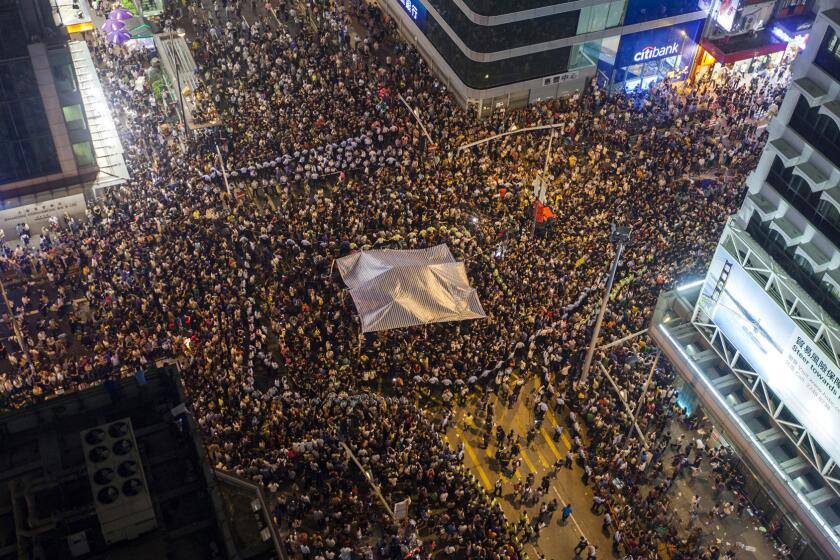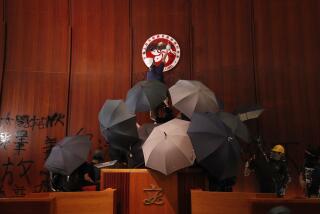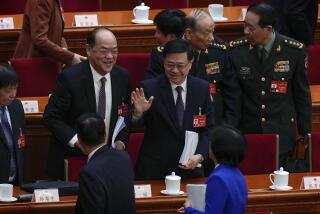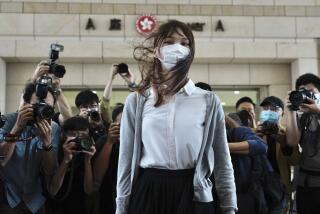Hong Kong protests: Hundreds of thousands spill out of pro-democracy rally and march across the city

Hong Kong protesters defied police restrictions and pouring rain to march across the city on Sunday, spilling out of a large public park and filling major streets in the latest chapter of a summer of pro-democracy demonstrations.
For the first time in 11 weeks of unrest, protesters successfully steered one another away from confrontation with the police, breaking a cycle of peaceful daytime protests that have turned into violent clashes after nightfall.
In doing so, they challenged portrayals by Chinese mainland and Hong Kong officials that they are violent thugs seeking to tear apart the territory. They also provided mainland authorities with no pretext to launch a feared military intervention.
The rally began in the afternoon at Victoria Park, the starting point for two peaceful marches in June that brought unprecedented numbers to the streets to oppose a bill that would have allowed for the extradition of criminal suspects to the mainland.
But the park could not accommodate their numbers on Sunday, and throngs of umbrella-toting demonstrators quickly spread through major roads, walking in different directions. Organizers said more than 1.7 million people participated; police said 128,000 people were in Victoria Park at its peak.
Police had approved the rally within the park but denied permission for a march, prompting the organizers, the Civil Human Rights Front, to appeal the decision because demonstrators were likely to march anyway.
Sunday’s rally was billed as a return to nonviolent demonstrations, one week after thousands of protesters occupied the Hong Kong airport, resulting in the cancellation of departing flights. Protesters that day clashed with police, blocked passengers from boarding planes, and accosted two suspected spies from mainland China, including a reporter for the Chinese state outlet Global Times.
Two hours before the rally’s 3 p.m. start time, thousands of protesters were already filling nearby subway stations and streaming into the park, clad in black clothing and opening umbrellas in a light rain that would soon grow heavier.
Trump and his lieutenants have signaled to Xi Jinping that the United States won’t object to China crushing the pro-democracy in Hong Kong.
Protesters who have turned out this summer to oppose the extradition bill — which they see as a threat to Hong Kong’s rule of law and a sign of Beijing’s growing control over the territory — have classified themselves into two groups: “the valiant,” who go to the front lines and clash directly with police, and “the peaceful, rational, nonviolent,” who support tactics such as rallies and marches.
In response to the largest popular uprising in Hong Kong, police have fired tear gas and rubber bullets regularly at protesters, some of whom throw bricks and gasoline bombs in return.
On Sunday, protesters said it was time for the valiant to compromise and support the peaceful, just as the peaceful have often stood behind protesters clashing with police on the front lines.
One protester dressed in the “valiant” costume — all black, with elbow pads, goggles and a mask — held up a handwritten sign in the middle of the park: “Peaceful, rational, nonviolent ... thank you for being my backup, never leaving me behind, supporting me even when you disagreed with my tactics! August 18th. No more division.”
A protester named Ray, 26, said he was “valiant” but still supported this kind of protest.
“We never thought these rallies were useless. We think it’s the most powerful way to express ourselves, because we can get millions of people and get our voice out globally,” said Ray, who, like several protesters, declined to give his full name to shield himself from official retribution.
Another “valiant” protester named Kelvin, 28, said he thought nonviolence was useless.
“It’s peaceful, but the government will ignore you,” he said. Yet he joined in hopes that larger numbers might exert some pressure on the government, he said.
Rally speakers said the purpose of this march was to return to the “peaceful, rational, and nonviolent means” of protest that had marked the movement’s beginning.
“Today’s assembly continues the will of the 2 million people who marched on June 16 against brutality,” said Wong Yik-mo, vice convener of the Civil Human Rights Front.
Although the government has suspended the extradition bill, protesters’ demands have expanded to include democratic reforms and greater accountability for the government and police, whom protesters accuse of excessive force and collusion with organized gangs called triads.
More than 700 protesters have been arrested, dozens of them charged with rioting, an offense punishable by up to 10 years in prison.
After the unrest at the airport, smaller rallies Friday and Saturday were peaceful, ending a week of reflection and online discussion in which many protesters urged a return to less aggressive tactics.
Beijing officials have said without evidence that the CIA is orchestrating Hong Kong’s protests. Officials have also said the protests show signs of terrorism and threaten China’s national sovereignty, which they have described as a “bottom line.”
In recent days, in an apparent show of force by Beijing, hundreds of armed paramilitary vehicles have been seen in Shenzhen, just across the border from Hong Kong. The People’s Liberation Army also maintains a garrison in Hong Kong, though the territory’s law forbids the military to intervene unless requested by the Hong Kong government.
Within minutes of the rally’s starting time, the park was full, with thousands overflowing into the streets. The crowds decided to march, shuffling forward in pouring rain while cheering a Cantonese phrase of encouragement: “Hong Kongers, add oil!”
Francis Woo, 35, stood on a platform in a nearby subway, sending texts to a group of 259 people on WeChat, the mainland Chinese messaging app.
Woo, a part-time subway station assistant, said the group was full of mainlanders in southern China, sending encouragement and asking for information about what was happening.
“There’s only one voice in their news, and it doesn’t make sense,” Woo said, referring to Chinese state media, which have blocked reports of peaceful rallies in Hong Kong while amplifying scenes of confrontation between protesters and police.
Woo said he didn’t support violent protest tactics but had marched in June and wanted mainlanders to know what was going on. This was the eighth version of this WeChat group, he said, after seven previous ones were shut down.
Near the building that houses the Legislative Council, Hong Kong’s administrative body, a group of about a dozen middle-aged and elderly volunteers, including one man with a walking stick, put on gas masks and yellow vests with the message “Protect the Children” printed on them. The group — parishioners from a church — planned to march alongside young protesters and defend them in case of attack by police or undercover gangs, said Edmund Chan, 59.
Veteran pro-democracy legislator Leung Yiu-chung stood near the world war memorial in Hong Kong’s central district, encouraging protesters to go home after marching.
“You can see that everyone is peacefully voicing their opinion,” Leung said, adding that there were no confrontations at that point because there were no police around. “No police, no violence.”
By late afternoon, there was no visible police presence even as the Hong Kong police force tweeted that two major thoroughfares had been “occupied” by demonstrators.
As night fell, a large number of anti-riot police officers gathered at the liaison office, home to Beijing’s representative in Hong Kong. But protesters seemed committed to avoiding confrontation, warning one another that it might be a trap.
One post on LIHKG, the Reddit-like platform protesters use to organize, suggested heading to the liaision office just as the police appeared. It got more than 5,000 down votes, with more than 50 pages of comments saying “No thanks.”
Many protesters returned to Victoria Park, where speeches about Hong Kong identity continued into the night, with some young protesters weeping as they shared their experiences.
Janice Iu, 35, handed out stickers she’d designed reading: “I support Hong Kong freedom and democracy. You can beat me now,” a satire on mainland Chinese praise for the reporter beaten in the airport Tuesday after allegedly saying, “I support Hong Kong police. You can beat me now.”
Iu said she hoped to bridge divisions between protesters and Hong Kongers who thought protests were creating instability.
“Most importantly, we’re not going to take revenge on the police. We know that police are the middleman for the government and the people,” she said. “We’re fighting for democracy and freedom for everyone in Hong Kong.”
At one point, crowds surrounded a mainlander -- but instead of tying him up, they took selfies with him, giving thumbs-up signs.
Late at night, some protesters in a crowd of several hundred youths around the Legislative Council building urged one another to go home rather than clash with police.
They linked arms and walked away from the building, chanting, “We win if we leave.”
Su is a Times staff writer and Kilpatrick a special correspondent.
More to Read
Start your day right
Sign up for Essential California for news, features and recommendations from the L.A. Times and beyond in your inbox six days a week.
You may occasionally receive promotional content from the Los Angeles Times.








